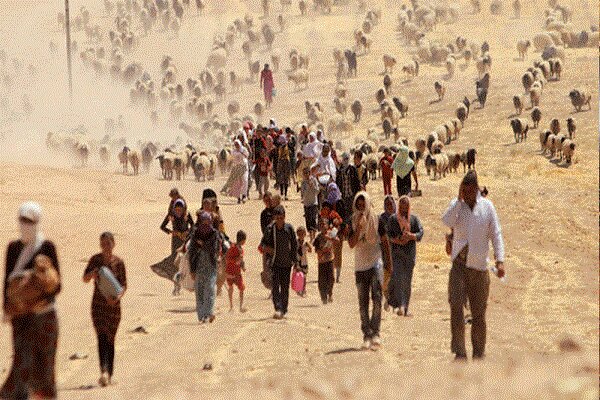Yazidis still suffering from repercussions of ISIS crimes: Yazidi activist

TEHRAN – The Yazidis in Iraq are still suffering from the repercussions of ISIS crimes, a Yazidi activist says.
On 3 August 2014, ISIL militants attacked and took over Sinjar in northern Iraq, a Kurdish-controlled town that was predominantly inhabited by Yazidis.
“On the 3rd of August 2014, the Yazidi regions and villages in Iraq were subjected to the most heinous massacre, abuse, kidnapping, mass and individual killing, chases, theft, land confiscation, crop burning, house demolitions, selling of women and children, killing of men and youth, and brainwashing of teenagers to change their religion and their ideas,” Murad Yazidi tells the Tehran Times.
“All this and more have been exercised against the Yazidis systematically, some crimes of which are still continuing, as more than 3,000 children and women are still missing or held in the terrorist camps,” the Yazidi activist adds.
Yazidis, an ethnoreligious minority group of about 550,000 people, mostly reside in northern Iraq, an area also populated by Kurds and Arabs.
ISIS regards the Yazidis as “devil worshippers” who must either renounce their religious views or die.
According to international organizations, ISIS was responsible for the killing and abduction of roughly 9,900 Yazidis and destroying 68 Yazidi shrines in 2014.
When the terrorist group entered the Yazidi ancestral city of Sinjar on Aug. 3, 2014, they murdered roughly 5,000 men and boys and enslaved thousands of women and children.
Following is the text of the interview:
Q: What is the meaning of the word Yazidi? Is it true that the beliefs of this sect are descended from ancient Persian religions such as Zoroastrianism and Manichaeism? Is there a common ritual between Yazidism and Zoroastrianism?
A: The word "Yazidi" in our language means “servants of God”. “Izady” means the one who created me.
It is a monotheistic, non-missionary religion that believes in one God and only God. Its roots return to the Indo-European religions and are not one of the ancient Persian religions such as Zoroastrianism and Manichaeism, as is rumored.
Although there are commonalities between Yazidism and Zoroastrianism, they are two separate religions since ancient times. There are sources confirming the seniority of the Yazidi religion, because it is considered a doctrine that crystallized and developed without a prophet or messenger that extends to the Sumerian and Babylonian eras, with evidence that most of its religious rituals are linked to nature and its sanctification.
However, the Yazidis consider Sheikh Adi (Sheikh Uday bin Musafir) the founder of their religion, neither a messenger nor a prophet.
Q: What are the main strongholds of the Yazidis in West Asia before and after the ISIS advent?
A: Some reports indicate that the original Yazidi population was in Turkey until the Ottomans came to power and began to expel and exterminate them, which led to reducing their numbers from millions to a few thousand.
A large number of them migrated to the former Soviet Union republics, and others to Iraq, which is so far considered their “largest and oldest home.”
There are some Yazidis in Syria, Georgia, Armenia and Russia. Recently, the number of Yazidis has increased dramatically in the European Union especially in Germany, which has more than 150,000 Yazidis. They are also present in America, Australia and Canada.
It is certain that the number of Yazidis has decreased in Iraq and Syria after the genocide they were subjected to at the hands of ISIS, while it has increased in Western countries and Europe by nearly a hundred thousand since August 2014.
Q: Can you update us about crimes ISIS committed against the Yazidis in Iraq and Syria?
A: On the 3rd of August 2014, the Yazidi regions and villages in Iraq were subjected to the most heinous massacre, abuse, kidnapping, mass and individual killing, chases, theft, land confiscation, crop burning, house demolitions, selling of women and children, killing of men and youth, and brainwashing of teenagers to change their religion and their ideas.
All this and more have been exercised against the Yazidis systematically, some crimes of which are still continuing, as more than 3,000 children and women are still missing or held in the terrorist camps.
ISIS as a terrorist organization followed the same approach as the elements of al-Qaeda did, where they killed the Yezidis on identity according to their false attitudes, considering the Yezidis as infidels or devil-worshippers.
This was a false accusation made by extremists for decades with the aim of seizing peoples’ lands and properties.
Q: How do you see Iran's efforts to support the Yazidis, especially during the ISIS invasion?
A: Actually, there was no special support for the Yazidis from Tehran but the Iranian government stood with the Iraqi defense forces to liberate many Iraqi lands from the cowardly ISIS, so this support was not only for the Yazidis.
Unfortunately, today the Yazidi regions have become an arena for political struggles between Iraqi groups after their liberation from ISIS.
Q: How do you see the performance of the international community in shedding light on what happened to the Yazidis?
A: I can say that the international community as a whole promised more than it contributed regarding support for the Yazidis and the Yazidi cause, but there are some European countries whose positions were honorable towards our humanitarian cause.
On the other hand, we are stunned by the silence of Arab and Islamic countries regarding support for the Yazidi cause, as it is a humanitarian issue that should be supported by all governments without exception.
Leave a Comment